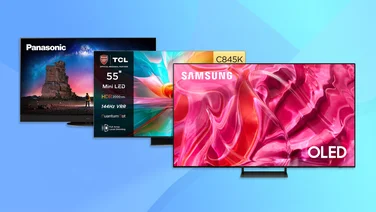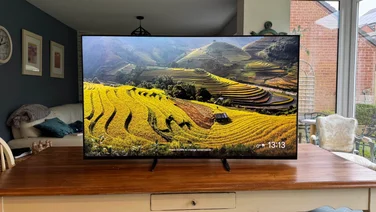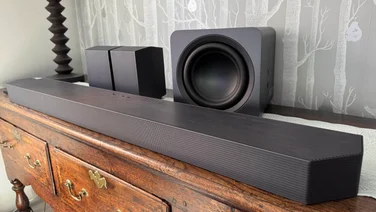To help us provide you with free impartial advice, we may earn a commission if you buy through links on our site. Learn more

The Philips 6400 Series is available in 43in (43PUS6401/12), 49in (49PUS6401/12) and 55in (55PUS6401/12) variants but there isn’t any difference between models aside from the size of the display (and power consumption). The same specifications and technologies are shared across the range, which should mean image quality will be practically identical.
Whichever screen size you choose, the 6400 range delivers an Ultra HD resolution, an Android TV interface and Philips’ trademark Ambilight illumination – where lights mounted behind the TV project colours in tandem with the onscreen images. On test here was the 43in model and the slender-bezeled TV was incredibly easy to set up, both physically and in terms of the Android TV interface.
Two pleasingly-simple feet just slot into the base and are fixed with just one screw each. The silver finish is unassuming and overall it’s rather charming to look at. There aren’t any embellishments, just the Philips logo at the bottom.
The feet provide 47mm of vertical clearance, enough for slender soundbases and soundbars, but on our 43in model you might struggle to fit many such devices between them – not a problem on the bigger screen sizes where there’s more room between to be found.

The Android setup process is very approachable in terms of visual design, with clear instructions and easy to read menus. It first takes you through the stages of connecting to your home network either through wireless or the Ethernet port on the rear. Once that’s done you can sign into your Google account, which you’ll want to do if you plan on taking advantage of Android TV.
The actual process of inputting text through the on-screen keyboard is laborious and sluggish. Moving between characters using the remote control’s incredibly clicky direction pad often saw presses not recognised or suddenly done in quick succession, resulting in missing the character you’re looking to type. You’ll encounter the same problem when entering text to make searches in Netflix and the like.
After this, you’re taken through some basic settings for adjusting the TV’s image and sound settings. It’s a reasonable jumping off point but you’ll likely want to make finer adjustments at a later time.
With all that done, you’ll get to experience the slightly disjointed menu system for Philips’ Android-based TVs. While the Android TV elements will be familiar to anyone who has used an Android device before, whether that’s a tablet or Android TV box, the rest of the TV menus, including the Live TV’s EPG, are of Philips’ own design.

While they look pleasant enough, it’s still a little unsettling to move between the two and the TV’s remote control is a testament to the many different menus and functions of the set. There’s quite a number of different buttons so it’ll take a while to remember their functions as the button icons aren’t particularly obvious. The remote control feels light and plasticky, too.
The EPG is detailed enough but I found changing channels slow. There’s a longer delay than I would like as the channel changes, and then the EPG appears horizontally across the centre of the screen displaying the current programme and what’s coming up. It’s irksome that it’s not placed lower down as not to immediately block your view of what’s on. There’s also no Freeview Play or other timeline based catch-up system. Combined with the lack of catch-up apps from the Android TV and it’s a disappointing package.
Android TV
The Android TV experience remains largely unchanged from when I saw it on the Google Nexus Player and Nvidia Shield TV, which means it still feels lacking. While the Shield TV and Nexus Player’s shortcomings could be overlooked if you were interested in Android gaming, this isn’t the case here as performance on even basic games like Crossy Road felt sluggish and unresponsive. Then there’s also the lack of a proper gamepad to make it something you would want to play games on in the first place. There are other apps available on Android TV, but you’ll struggle to care about most of them. There’s also no microphone built into the Philips TV’s remote control to take advantage of Android TV’s voice recognition, which is a shame.
There are other apps available on Android TV, but you’ll struggle to care about most of them. There’s also no microphone built into the Philips TV’s remote control to take advantage of Android TV’s voice recognition, which is a shame.

But it’s the paucity of terrestrial catchup services that remains the glaring issue – there’s essentially just BBC iPlayer. As for streaming on demand, there’s currently Netflix but no Amazon Prime Video. When smart TVs from the likes of Samsung and Panasonic have the full stable, one begins to wonder why Philips still opts to keep using Android TV for its TVs. There is at least built-in Google Cast support, which opens up additional options for getting access to content on your big screen but it’s more a sticking plaster than a fix.
Image quality
The out-of-the-box viewing experience is a little underwhelming. Colours are subdued and everything looks washed out, owing to a lack of contrast. Delving into the TV’s menus it becomes evident that it had defaulted to its Standard picture mode, which uses energy conservation. That’s all fine and good for the eco-sensitive, but if you’re looking to get the best image quality out of the TV you’ll want to choose a different picture mode. Using our colour calibrator to measure the Movie preset, the TV’s black levels of 0.23cd/m2 is rather high, while the maximum brightness of 251.9cd/m2 is rather low. All this equates to a rather disappointing 1,077:1 contrast ratio.
Colour accuracy of the sRGB colour gamut was 93.1% without any calibration, which isn’t a bad starting point. The ISF Day and ISF Night presets allow you a good amount of customisation for white balance and RGB levels, so with a little experimenting, you can improve the colour reproduction. Frustratingly, any changes you make are saved to that particular source, so you’ll need to manually repeat them for each input source rather than the TV letting you automatically duplicate your changes across sources.
The TV’s upscaling isn’t particularly good, either, especially on broadcast HD channels. Picture quality looks smeared and skin tones lack detail. Upscaled Blu-rays proved better but still looked a little soft. If you’re interested in gaming, I measured lag at 46ms on the TV’s standard mode, which dropped to 29ms when the TV is set to its dedicated Game mode. This is reasonable for most console gaming.
Philips has finally added HDR support, too, which rectifies several issues I had with the TV when I first reviewed it, so if you bought this TV before June then you’ll need to update it. HDR support comes in over a free over-the-air update, and provides a noticeable improvement to the TV’s overall picture quality. Colours look much richer and more vibrant, and there’s now a lot more detail in the very brightest parts of the screen as well as the very darkest. The update also includes Ultra HD streaming support for Amazon Video, giving you even more choice to getting the most out of its 4K HDR capabilities.

Philips Ambilight
Philips’ TV party trick makes a return here in the form of its Ambilight. For this model it’s the 2-sided version, meaning lights are emitted from either side of the screen onto the surrounding walls. You have a number of options as to how the Ambilight is used, such as adapting to what’s displayed on the screen or pulsing based on sound. You can select colours for mood-lighting too or even have it work in tandem with Philips Hue lights.
My favourite mode was just to have it use what was on the screen. I was actually quite fond of it, especially as you can always tone it down or turn it off completely at times when you do find it distracting; with a quick access button on the remote control to get to the settings. There are certain points where it does feel more immersive, and when those moments arise it is rather delightful.
Watching the trailer for The BFG on YouTube, for example, there’s a moment where a torch is carried across the screen and watching the orange glow emanate out of the side and follow the torch as it moved across the screen was impressive. Ambilight makes the most sense when there’s a focal source of light, like a cars headlights or explosion, perhaps less so when the green of a tree shines out the side of your TV.
Connections
The rear of the TV has two HDMI ports, a component input and even a SCART connection alongside a USB port. There’s a coaxial satellite connection as well as the aerial socket. The side of the TV has two more HDMI ports alongside two USB ports, one of which is the faster USB3 standard. The USB ports can be used to connect external storage if you want to record TV using its single tuner.
You can use the optical S/PDIF output on the rear for connecting a soundbar or alternatively any of the HDMI ports as all of them support ARC (Audio Return Channel, for sending audio from the TV out to other devices). Only the rear HDMI ports support HDCP 2.2, although that’s unlikely to be a big problem in the foreseeable future.
Conclusion
Like the manufacturer’s other entry-level 4K TV, the 40PUT6400, there’s a lot of the same problems where it comes to the interface and a lack of catchup services. The added HDR goes a long way to rectify some of the previous issues I had with the TV, however, and I’m very fond of its Ambilight capabilities, so I’ve bumped it up a star to reflect this improvement.
That said, it still faces a lot of competition from Panasonic’s Viera TX-40DX700B. Not only does it fall in the same kind of price ballpark, but Panasonic’s interface, built-in Freeview Play EPG, and overall picture quality are far superior, claiming my recommendation over the Philips 43PUS6401/12.
Buy the Philips 43PUS6401/12 now from Argos
| HARDWARE | |
|---|---|
| Screen size | 43in |
| Native resolution | 3,840×2,160 |
| Aspect ratio | 16:9 |
| 3D | No |
| Contrast ratio | Not disclosed |
| Brightness | 350cd/m2 |
| Speakers | 20W |
| Video inputs | 4x HDMI, Component, SCART |
| Audio inputs | None |
| Audio outputs | Optical S/PDIF, HDMI ARC |
| Tuner | Freeview HD |
| Streaming TV services | BBC iPlayer |
| Media Streaming | DLNA |
| Dimensions | 623x968x204mm |







